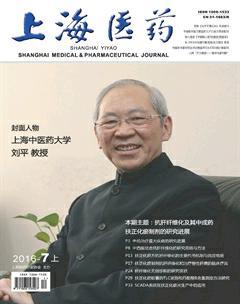光动力治疗过程中的疼痛和缓解对策
曹峰
摘 要 目的:调查光动力治疗(photodynamic therapy,PDT)过程中疼痛的相关影响因素,以及缓解疼痛的有效方法。方法:在PubMed数据库中检索PDT过程中疼痛的临床研究文献,并对数据进行总结。结果:治疗过程中的疼痛是PDT最常见的不良反应。与疼痛相关的因素包括光敏剂类型、病损部位和大小、辐照剂量、光源类型和波长等。多种疼痛缓解对策已经被研究,大多数研究显示,外用局麻药物对缓解PDT疼痛无效。对治疗部位冷却能部分缓解PDT疼痛,但效果是不充分的。神经阻滞可以有效地缓解PDT疼痛。结论:治疗部位冷却是缓解PDT疼痛,提高患者耐受度最简单、最经济的方法,作为临床优先方案被推荐使用。对于简单冷却效果不佳的患者,可以选择神经阻滞来有效控制PDT过程中的疼痛。
关键词 光动力治疗 疼痛 缓解
中图分类号:R459.9 文献标识码:A 文章编号:1006-1533(2016)13-0062-04
Pain during photodynamic therapy and its relief strategies*
CAO Feng**
(Shanghai Fudan-Zhangjiang Bio-Pharmaceutical Co. Ltd., Shanghai 201210, China)
ABSTRACT Objective: To investigate the factors of pain associated with photodynamic therapy (PDT) and find the effective methods for relieving the pain during treatment. Methods: The literature on the clinical research of pain resulting from PDT was thoroughly searched for by PubMed and the published data were summarized. Results: The pain during PDT is the most commonly reported adverse effect. Various factors influencing pain include the type of photosensitizer, the site and size of lesion, irradiation dose, light source and wavelength. Numerous strategies for relieving pain during PDT have been studied. The most studies showed that topical anesthetics had no benefit to relieving the pain from PDT. Cooling the site of PDT treatment could partially relief the pain but the efficacy was insufficient. Nerve blocks could efficiently relief the pain during PDT. Conclusion: Cooling the site during illumination is an easy and inexpensive way to make PDT treatment more tolerable for the patient and has been recommended as a priority scheme to be used in clinic. For rare cases in which cooling simply fails to control the pain, nerve block can be adopted.
KEY WORDS photodynamic therapy; pain; relief
光动力治疗(photodynamic therapy,PDT)是20世纪80年代开始的一项新型临床诊疗技术,该技术利用光敏药物和特定波长光源设备的联合作用,对肿瘤、血管性疾病等局部病灶实施靶向治疗,现临床广泛应用于体表某些非黑色素皮肤癌的非侵入性治疗,其有效性、安全性及治疗后的美容效果被充分认可。PDT的主要不良反应是治疗过程中的疼痛感,接受治疗的大部分患者均报告了疼痛的不良反应,个别患者甚至因为难以忍受疼痛而中断或放弃采用PDT治疗。本文就已发表的相关临床实践进行综述,以期寻找有效且具可操作性的PDT过程中疼痛的缓解对策。
1 PDT疼痛的机制
PDT过程中疼痛有较大的个体差异,且具有不可预测性,其作用机制迄今尚未得到清晰阐述,目前的主流观点是:PDT过程中,位于有髓鞘的δA神经纤维和无髓鞘的C神经纤维末端受体受到神经刺激,是产生疼痛感的最主要因素;PDT导致治疗部位病变细胞坏死,引起局部炎症反应,对疼痛感的产生也有一定的影响;光辐照时,治疗光源辐照传递的高热能量也是引起疼痛的另一个可能因素[1]。
2 PDT过程中疼痛的相关因素
2.1 光敏药物类型
多项研究结果显示,疼痛强度和光敏药物类型相关。Gholam等[2]报道了173例光化角化病患者,分别用相同剂量的光敏药物氨基乙酰丙酸甲酯(MAL)和氨基乙酰丙酸盐酸(ALA)纳米乳后实施PDT,结果发现,使用MAL组有更低的疼痛感和更少的治疗中断比例。Kasche等[3]也报道了相似的结果,使用MAL实施PDT,有14%的患者因疼痛而终止治疗,而使用ALA,有54%的患者因疼痛终止治疗。
2.2 损伤的位置、大小
研究认为,实施PDT的病损部位对疼痛强度的影响很大[4-5],感觉神经密集部位的疼痛感更强烈,即头部、面部>躯干及四肢。其次,损伤面积越大,因疼痛而中断治疗的发生越频繁[5-6]。
2.3 光辐照强度
多数研究认为,PDT时的光辐照强度越大,患者的疼痛强度越高。Apalla等[7]报道了50例光化性角化病患者使用光敏药物ALA后,分别给予25、50、75 mw/cm2光辐照强度实施PDT,总辐照光剂量均为75 J/cm2。研究结果显示,25和50 mw/cm2两组间的疼痛强度没有明显区别,但75 mw/cm2组的疼痛强度明显更高,和前述任意组均有统计学显著差异。
2.4 光源类型和辐照波长
PDT使用的光源类型会影响患者的疼痛感受,脉冲式光源的疼痛感弱于连续式光源,LED光源的疼痛感强于激光光源[8]。此外,使用不同的波长辐照时,疼痛感也有所差异,蓝光和绿光产生的疼痛感较轻,而红光的疼痛感更强,或与不同波长在组织内的穿透能力差异相关[9]。
3 PDT过程中疼痛的缓解对策
已有数种PDT过程疼痛的缓解对策被研究,包括治疗部位降温、表面麻醉、局部浸润麻醉、神经阻滞麻醉、降低光辐照强度和调整光辐照方式等。
3.1 治疗部位降温
临床常用的降温方法包括在治疗部位连续或间歇式给予冷风或冷水喷淋。Stangeland等[10]的研究认为,对于中等程度的PDT疼痛,给予冷风是一种有效、简单和非侵入性的缓解方法。Wiegell等[11]的研究也得到了相同的结论,但总体而言,此种方式对疼痛的缓解效果是有限的,更多的作用体现在治疗部位降温使得患者对于疼痛有更好的耐受度,从而可以完成治疗。
3.2 表面麻醉
没有表面麻醉药物被证实可缓解PDT过程中的疼痛[12]。临床医师在多项研究中使用了各种表面麻醉药物,如:EMLA、利多卡因、丁卡因和吗啡等,均没有实现缓解疼痛的效果。一种可能的解释是常用光敏药物ALA和MAL均是酸性的,而大多数的表面麻醉药为碱性,使得两者组合使用时是不兼容的。此外,碱性环境也会影响光敏药物的稳定性。
3.3 局部浸润麻醉
局部浸润麻醉是临床体表小手术镇痛的主要选择之一。Girard等[13]研究发现,采用罗哌卡因-利多卡因局部浸润麻醉法能很好地缓解多发性基底细胞癌患者PDT过程中的疼痛,所有受试者均完成了治疗。Borelli 等[14]比较了口服止痛药及联合局部浸润麻醉的镇痛效果,结果显示,仅口服镇痛药不能缓解PDT过程中的疼痛,但在联合局部浸润麻醉后,94%的患者疼痛感有显著降低。
3.4 神经阻滞麻醉
神经阻滞是将局部麻醉药注射至外周神经干的周围,暂时阻断神经纤维的传导功能,达到阻滞神经所支配区域的麻醉或无痛。多项临床研究结果显示,神经阻断能有效地缓解PDT过程中的疼痛。
Paoli等[15]对16例面部广泛性光角化病患者实施PDT,单侧神经阻滞,另侧作为对照,结果显示有显著性差异,神经阻滞侧基本无疼痛感。Halldin等[16]采用类似方案对10例面部广泛性光角化病患者实施PDT,神经阻滞侧的平均视觉模拟评分(VSA)为1 ,对照侧为 6.4,疼痛有显著缓解。相较于治疗部位降温方式,神经阻滞缓解疼痛的效果明显更好[17]。
3.5 降低辐照强度
光辐照强度是局部PDT时产生疼痛的重要因素之一,因此临床实践时可采用降低辐照强度的方式来缓解疼痛,目前的经验是:当采用不高于50 mw/cm2的辐照强度时,绝大部分患者可以耐受PDT过程中的疼痛并完成治疗。Braathen [18]和Ibbotson等[19]的研究显示,采用较低的辐照强度,患者的疼痛感显著降低,并可获得与对照组类似的临床疗效。
3.6 间歇辐照
间歇式辐照也是可采用的降低PDT过程中疼痛的一种方法。Wiegell等[11]在PDT过程中持续冷水喷淋,并将整个辐照过程分成两段,中间间隔3 min,结果显示,第一阶段单纯冷水喷淋仅轻微降低疼痛感,暂停辐照后疼痛感显著降低,并在第二阶段疼痛感仅少量增高(需同时配合冷水喷淋),显示间歇辐照方式对降低疼痛有一定效果。
4 讨论
综合上述临床研究文献,PDT过程中的疼痛主要与疾病的类型、病损部位和大小、使用的光敏药物、光辐照强度和光辐照方式密切相关,而与患者的性别、年龄以及皮肤类型关系不大。
常用的几种缓解疼痛的方法:①外用表面麻醉药物对缓解PDT疼痛无效。②在治疗部位给予冷风或冷水喷淋降温对降低疼痛强度效果不明显,但可以提高患者对疼痛的耐受度,使更多患者完成PDT。局部冷却方法使用方便、成本低廉,基本无安全风险,且对治疗产生的红肿、水泡等不良反应也有一定的缓解作用。③局部浸润麻醉对缓解PDT疼痛效果良好,但操作相对复杂。如局部注射肾上腺素或导致血管收缩影响临床疗效。④神经阻滞后PDT过程中基本无疼痛感,是已知效果最好的局部镇痛方法,其主要临床问题是对于小儿和部分恐惧紧张的患者或难以施行。⑤降低辐照强度或调整辐照方式等对缓解疼痛有一定的效果,但通常会导致PDT时间延长,在实际临床应用中或存在问题,而且降低辐照强度后是否仍能保证高强度时的临床疗效,目前仍缺乏大样本量循证证据支持,需进一步观察。
综上所述,推荐医师在进行PDT时,优先采用治疗局部降温方式缓解疼痛;仍无法耐受的少量强烈疼痛患者,推荐采用神经阻滞方式镇痛;对于较低龄的儿童,因较难准确神经定位,且清醒时很难配合穿刺过程,神经阻滞麻醉的可行性很低,建议采用吸入或静脉麻醉等方式。
参考文献
[1] Chaves YN, Torezan LA, Niwa ABM, et al. Pain in photodynamic therapy: mechanism of action and management strategies [J]. An Bras Dermatol, 2012, 87(4): 521-529.
[2] Gholam P, Weberschock T, Denk K, et al. Treatment with 5-aminolaevulinic acid methylester is less painful than treatment with 5-aminolaevulinic acid nanoemulsion in topical photodynamic therapy for actinic keratosis [J]. Dermatology, 2011, 222(4): 358-362.
[3] Kasche A, Luderschmidt S, Ring J, et al. Photodynamic therapy induces less pain in patients treated with methyl aminolevulinate compared to aminolevulinic acid [J]. J Drugs Dermatol, 2006, 5(4): 353-356.
[4] Zeitouni NC, Paquette AD, Housel JP, et al. A retrospective review of pain control by a two-step irradiance schedule during topical ALA-photodynamic therapy of non-melanoma skin cancer [J]. Laser Surg Med, 2013, 45(2): 89-94.
[5] Buinauskaite E, Zalinkevicius R, Buinauskiene J, et al. Pain during topical photodynamic therapy of actinic keratoses with 5-aminolevulinic acid and red light source: randomized controlled trial [J]. Photodermatol Photo, 2013, 29(4): 173-181.
[6] Miller I, Nielsen J, Lophaven S, et al. Factors related to pain during routine photodynamic therapy: a descriptive study of 301 patients [J]. J Eur Acad Dermatol, 2011, 25(11): 1275-1281.
[7] Apalla Z, Sotiriou E, Panagiotidou D, et al. The impact of different fluence rates on pain and clinical outcome in patients with actinic keratoses treated with photodynamic therapy [J]. Photodermatol Photo, 2011, 27(4): 181-185.
[8] Warren CB, Karai LJ, Vidimos A, et al. Pain associated with aminolevulinic acid-photodynamic therapy of skin disease [J]. J Am Acad Dermatol, 2009, 61(6): 1033-1043.
[9] Halldin CB, Gillstedt M, Paoli J, et al. Predictors of pain associated with photodynamic therapy: a retrospective study of 658 treatments [J]. Acta Derm-venereol, 2011, 91(5): 545-551.
[10] Stangeland K, Kroon S. Cold air analgesia as pain reduction during photodynamic therapy of actinic keratoses [J]. J Eur Acad Dermatol, 2012, 26(7): 849-854.
[11] Wiegell SR, Haedersdal M, Wulf HC. Cold water and pauses in illumination reduces pain during photodynamic therapy:a randomized clinical study [J]. Acta Derm-venereol, 2009, 89(2): 145-149.
[12] Fink C, Enk A, Gholam P. Photodynamic therapy-Aspects of pain management [J]. J Dtsch Dermatol Ges, 2015, 13(1): 15-22.
[13] Girard C, Debu A, Bessis D, et al. Treatment of Gorlin syndrome (nevoid basal cell carcinoma syndrome) with methylaminolevulinate photodynamic therapy in seven patients, including two children: interest of tumescent anesthesia for pain control in children [J]. J Eur Acad Dermatol, 2013, 27(2): e171-e175.
[14] Borelli C, Herzinger T, Merk K, et al. Effect of subcutaneous infiltration anesthesia on pain in photodynamic therapy: a controlled open pilot trial [J]. Dermatol Surg, 2007, 33(3): 314-318.
[15] Paoli J, Halldin C, Ericson MB, et al. Nerve blocks provide effective pain relief during topical photodynamic therapy for extensive facial actinic keratoses [J]. Clin Exp Dermatol, 2008, 33(5): 559-564.
[16] Halldin C, Paoli J, Sandberg C, et al. Nerve blocks enable adequate pain relief during topical photodynamic therapy of field cancerization on the forehead and scalp [J]. Brit J Dermatol, 2009, 160(4): 795-800.
[17] Klein A, Karrer S, Horner C, et al. Comparing cold-air analgesia, systemically administered analgesia and scalp nerve blocks for pain management during photodynamic therapy for actinic keratosis of the scalp presenting as field cancerization: a randomized controlled trial [J]. Brit J Dermatol, 2015, 173(1): 192-200.
[18] Braathen LR. Daylight photodynamic therapy in private practice in Switzerland: gain without pain [J]. Acta Dermvenereol, 2012, 92(6): 652-653.
[19] Ibbotson SH. Irradiance is an important determinant of pain experienced during topical photodynamic therapy [J]. J Am Acad Dermatol, 2011, 65(1): 201-202.

